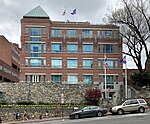The Bayou
The Bayou was a music venue and nightclub located in Georgetown, Washington, D.C. The club occupied an old building at 3135 K Street, NW, in Georgetown, under the Whitehurst Freeway for forty-six years. The club opened in September 1953 on the site of a former Dixieland nightclub called The Pirates Den which featured Dixieland jazz until the early 1960s when the format changed to rock and roll. Performers included Count Basie and Woody Herman.The club included a balcony level, with tables and chairs, and two standing room only bars. The main floor bars were fed bottled liquor from a "tap" room that was situated above the entrance. Bottles placed upside down into funnels feeding long tubing led to the downstairs bars. The Bayou backed up to another famed D.C. music institution, Blues Alley, located down the alley behind the Bayou.
Excerpt from the Wikipedia article The Bayou (License: CC BY-SA 3.0, Authors).The Bayou
Capital Crescent Trail, Washington Georgetown
Geographical coordinates (GPS) Address Nearby Places Show on map
Geographical coordinates (GPS)
| Latitude | Longitude |
|---|---|
| N 38.9024 ° | E -77.0619 ° |
Address
Capital Crescent Trail
Capital Crescent Trail
20566 Washington, Georgetown
District of Columbia, United States
Open on Google Maps







